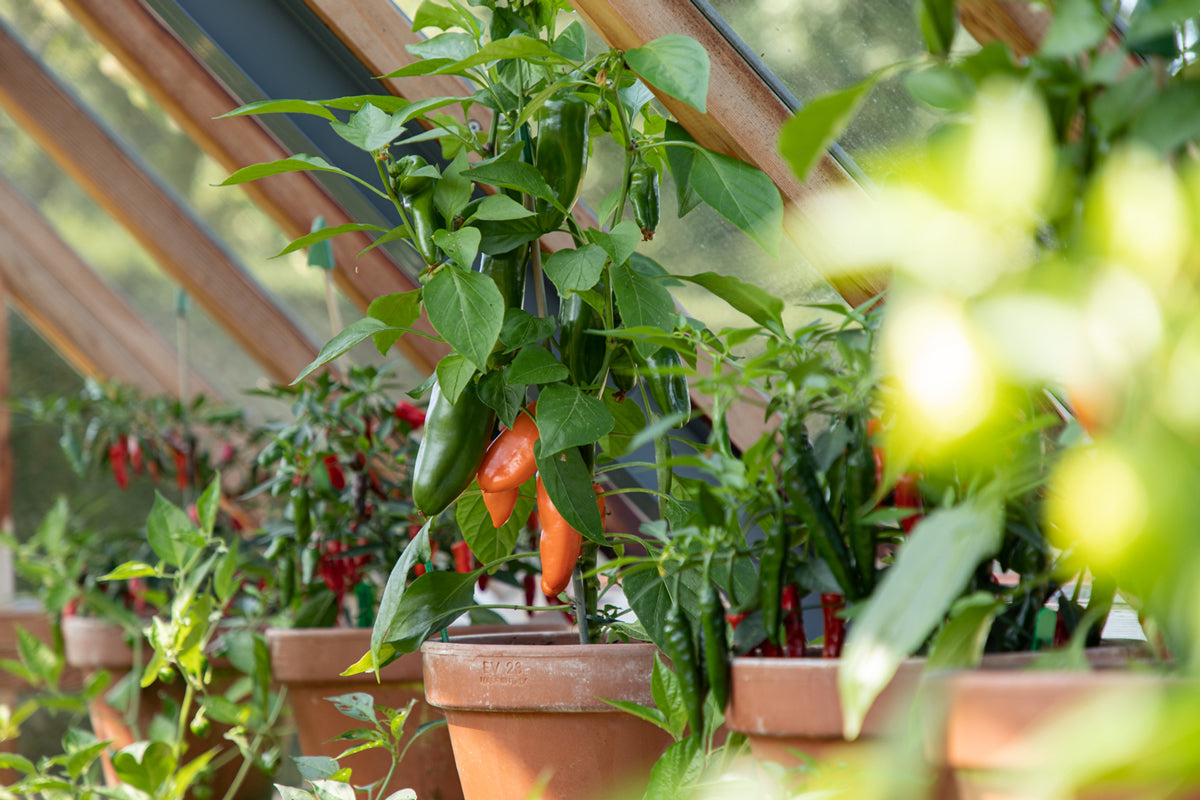August in the Greenhouse and Garden

August always catches me out, one minute I am enjoying relaxing in the summer garden on the late summer evenings, the next minute there are a multitude of jobs to do and the onset of Autumn is looming.
The month of August sees the garden at its peak with much of the garden coming into full bloom with flowers, fruits and vegetables all ripening and providing plentiful crops. The shame of it is, many of us choose this month to leave the garden behind for holidays. Just when it is at its prime we go on our trips away leaving neighbours and parents to enjoy the fruits of our labour. This year though things have been different and many of us have been able to experience our gardens through all the seasons including high summer.
With crops and flowers coming thick and fast the month is always a busy one. Whether you are dead heading flowers to keep the blooms coming, or harvesting vegetables like courgettes, carrots, tomatoes or chillies, there is always a job to be found.
Jobs for the Greenhouse

Tomatoes
Depending on the variety of tomatoes you are growing, they are either in, or fast approaching their peak with regards to harvesting their crops. I usually clip off unwanted foliage through the summer to let in more light, a tip I learnt from my Uncle. If this is something that causes you concern, I know the first year I did this I worried I would kill the plants, but take my word for it this is the best approach to getting your crops to ripen. Start by taking away the bottom half of the leaves on each plant which lets in light and air, speeding up the ripening process. You can keep stripping away the leaves until there are virtually none left. Although I have seen this on my Uncles plants, which he had very successful crops from, I still find this complete strip back difficult to undertake. I do also take out the tops of the tomato plants to stop them trying to produce new flowers. This means they can concentrate all their energy into ripening the fruits already produced. Care needs to be taken when watering now, slowly reducing the water volume apart from very hot days. Keep an eye on the compost and try to keep it from drying out but not too wet, which can lead to the fruits splitting. I do keep giving the plants a weekly tomato feed and find the best way to remember to do this is by doing it on a Friday - ‘Feed Friday’ an idea I picked up from Monty Don on BBC Gardeners World, has become a ritual for me.
Taking Cuttings
Free plants are one of the joys of gardening and a greenhouse provides the perfect opportunity to do this. Semi ripe cuttings taken from lavender, rosemary or verbena bonariensis are, from my experience some of the easiest ones to start with. Start by selecting a healthy strong stem, free from any flowers or buds. With a sharp knife or secateurs take a cutting below a pair of leaves. Strip away the lower leaves leaving only about an inch (25mm) of green foliage. Once prepared, push the stem down the side of a plant pot with a very gritty compost mix. Three to four cuttings can be placed around the edge of a small plant pot. To form the roots you just need to keep the cuttings in a greenhouse, out of full sun and ensure the compost is moist but not over watered. It’s advisable to mist the plants to keep the foliage healthy and give the roots chance to form. As you start to see new growth this is a sign the plants have rooted and at this stage they will need re-potting into fresh compost with more nutrients. The whole process if done at this time of year can take between 4 to 6 weeks, and doing it now makes it more likely the plants will root.
Autumn Salads in the Greenhouse
In our greenhouse we sow pots of hardy salad crops in August ready for harvesting in October and November, they might even push through winter depending on the weather and sunlight levels. Choose varieties of lettuce like ‘Salad Bowl’ or Rocket, Mizuna and spinach. My preferred option is to sow thinly in large pots, using it as a “cut and come again” crop.

Jobs for the Garden
Hedges
August is the month I try to cut all the hedges in our garden. Before having a garden with lots of hedges I did consider this to be a September task. However, August is definitely the preferred month, if simply because as we enter into September the weather can not be guaranteed and we can surely find a dry weekend in August, even in the British climate! This late summer trim brings back a new order to the garden with the perfect lines of the hedges once more reinstated. This form and order gives the rest of the more loose and exuberant plants the perfect backdrop to perform their late summer show. We can also sit back sure in the knowledge that this shape and form will give the garden a perfect structure to see it though the winter.
Rhododendrons and Azaleas
If like me your rhododendrons and azaleas struggled to flower this spring, it is due to the buds not forming properly last summer and autumn. If the shrubs become too dry over the coming weeks the buds will not form properly. Ideally use rain water but it is vital over the next couple of months that they do not dry out too much. If you keep on top of the watering they will reward you with glorious blooms next year. I also have two varieties of camellia in our garden but these, unlike the rhododendrons, had beautiful blooms in spring. It might be my Derbyshire clay soil that they like or simply their position, but although they too form their flower buds now, I have not noticed as many problems as I have found with the Rhododendrons.
Collect Seeds
As a rough guide seeds form roughly two months after flowering. As mentioned earlier one of the great things about gardening is free plants, and what better way to increase your stock than collecting seeds from your favourite plants. Always collect seeds on a dry warm day and from healthy plants. Leave the seed heads in a warm place like the greenhouse to fully dry out. Not all seeds store well, some like hellebore are best sown immediately. Gather seeds and collect them in paper packets or brown envelopes ready to sow. Always ensure you label the packets with what is inside.
There are so many different types of seeds to cover, that this short blog does not give me the opportunity to cover them all. If like me you have been inspired to grow more from seed, following this years events, what better way to practice than with free seeds from our own gardens. Above all remember August is not just a time for jobs, take the opportunity to enjoy the garden this month before we slowly start to slip into Autumn.
Words and images by Mark Spencer



